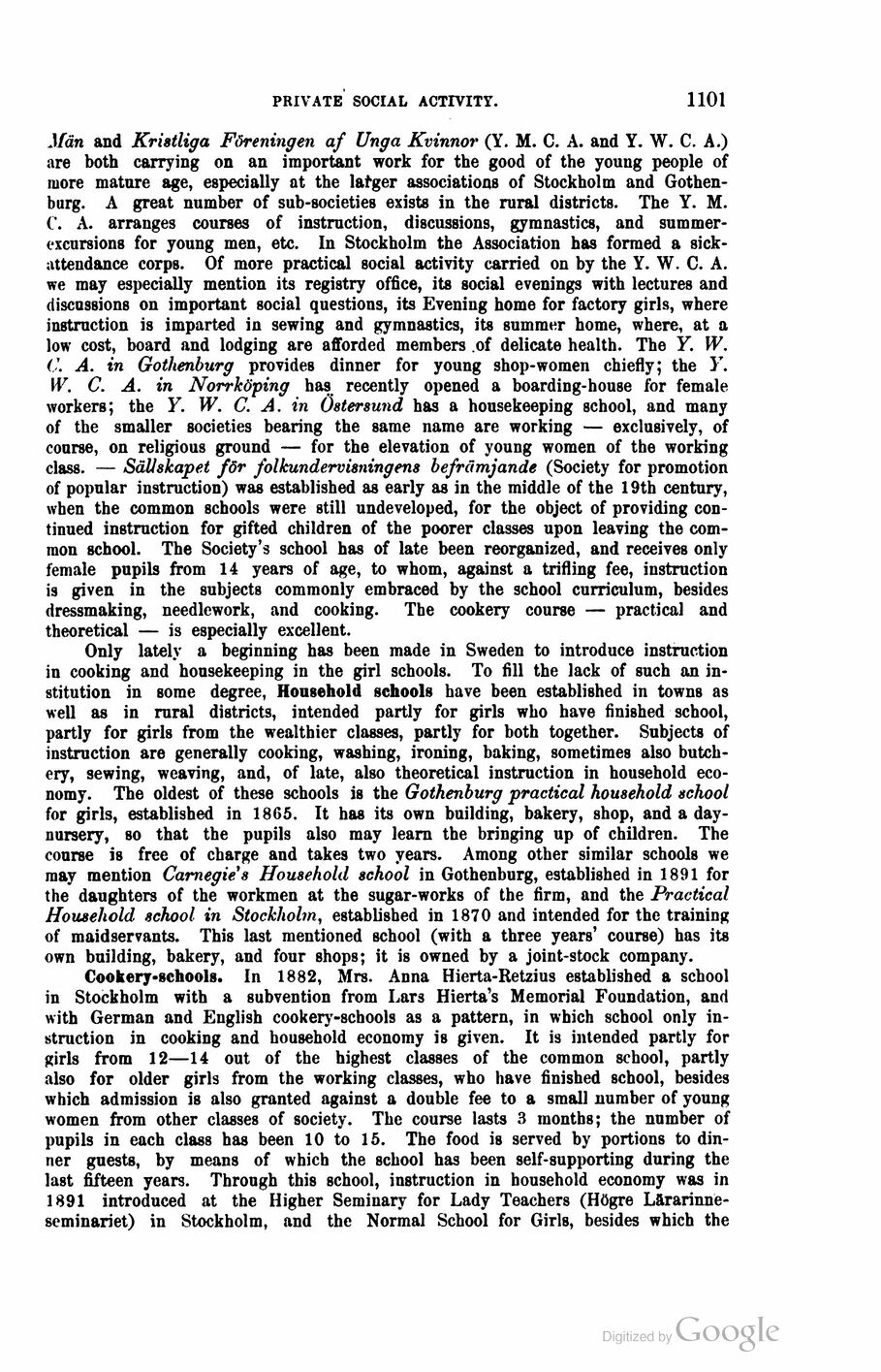
Full resolution (JPEG) - On this page / på denna sida - Second part - XVI. Labour Legislation and Social Statistics - 2. Social Condition and Social Statistics - Private Social Activity, by Miss Gerda Meyerson, Stockholm, partly after information given by Mrs. Anna Hierta-Retzius, Stockholm, and A. Ramm, City Auditor, Gothenburg

<< prev. page << föreg. sida << >> nästa sida >> next page >>
Below is the raw OCR text
from the above scanned image.
Do you see an error? Proofread the page now!
Här nedan syns maskintolkade texten från faksimilbilden ovan.
Ser du något fel? Korrekturläs sidan nu!
This page has never been proofread. / Denna sida har aldrig korrekturlästs.
private social activity.
1101
Mån and Kristliga Föreningen af Unga Kvinnor (Y. M. C. A. and Y. W. C. A.)
are both carrying on an important work for the good of the young people of
more mature age, especially at the latger associations of Stockholm and
Gothenburg. A great number of sub-societies exists in the rural districts. The Y. M.
C. A. arranges courses of instruction, discussions, gymnastics, and
summer-excursions for young men, etc. In Stockholm the Association has formed a
sick-attendance corps. Of more practical social activity carried on by the Y. W. C. A.
we may especially mention its registry office, its social evenings with lectures and
discussions on important social questions, its Evening home for factory girls, where
instruction is imparted in sewing and gymnastics, its summer home, where, at a
low cost, board and lodging are afforded members of delicate health. The Y. W.
V. A. in Gothenburg provides dinner for young shop-women chiefly; the Y.
W. C. A. in Norrköping has recently opened a boarding-house for female
workers; the Y. W. C. A. in Östersund has a housekeeping school, and many
of the smaller societies bearing the same name are working — exclusively, of
course, on religious ground — for the elevation of young women of the working
class. — Sällskapet för folkundervisningens befrämjande (Society for promotion
of popular instruction) was established as early as in the middle of the 19th century,
when the common schools were still undeveloped, for the object of providing
continued instruction for gifted children of the poorer classes upon leaving the
common school. The Society’s school has of låte been reorganized, and receives only
female pupils from 14 years of age, to whom, against a trifling fee, instruction
is given in the subjects commonly embraced by the school curriculum, besides
dressmaking, needlework, and cooking. The cookery course — practical and
theoretical — is especially excellent.
Only lately a beginning has been made in Sweden to introduce instruction
in cooking and housekeeping in the girl schools. To fill the lack of such an
institution in some degree, Household schools have been established in towns as
well as in rural districts, intended partly for girls who have finished school,
partly for girls from the wealthier classes, partly for both together. Subjects of
instruction are generally cooking, washing, ironing, baking, sometimes also
butchery, sewing, weaving, and, of låte, also theoretical instruction in household
economy. The oldest of these schools is the Gothenburg practical household school
for girls, established in 1865. It has its own building, bakery, shop, and a
day-nursery, so that the pupils also may learn the bringing up of children. The
course is free of charge and takes two years. Among other similar schools we
may mention Carnegie’s Household school in Gothenburg, established in 1891 for
the daughters of the workmen at the sugar-works of the firm, and the Practical
Household school in Stockholtn, established in 1870 and intended for the training
of maidservants. This last mentioned school (with a three years’ course) has its
own building, bakery, and four shops; it is owned by a joint-stock company.
Cookery-schools. In 1882, Mrs. Anna Hierta-Retzius established a school
in Stockholm with a subvention from Lars Hierta’s Memorial Foundation, and
with German and English cookery-schools as a pattern, in which school only
instruction in cooking and household economy is given. It is intended partly for
girls from 12—14 out of the highest classes of the common school, partly
also for older girls from the working classes, who have finished school, besides
which admission is also granted against a double fee to a small number of young
women from other classes of society. The course lasts 3 months; the number of
pupils in each class has been 10 to 15. The food is served by portions to
dinner guests, by means of which the school has been self-supporting during the
last fifteen years. Through this school, instruction in household economy was in
1891 introduced at the Higher Seminary for Lady Teachers (Högre
Lärarinneseminariet) in Stockholm, and the Normal School for Girls, besides which the
<< prev. page << föreg. sida << >> nästa sida >> next page >>